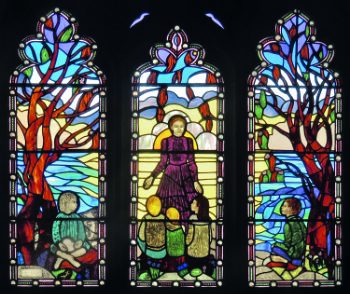August in Stained Glass
August is a month with a host of notable feasts. Three of these have already been covered in previous Stained Glass articles -- the Transfiguration: August 2017; Assumption and Queenship of Mary: March 2017.
On 3 August we celebrate St Dominic, who founded the Dominican Order in 1215. The story is told that his pregnant mother dreamt that she gave birth to a dog carrying a flaming torch in its mouth which “seemed to set the earth on fire”. That story obviously was the inspiration for this window [1] in St Patrick’s, Church Hill, Sydney. The rosary he is holding is reputed to have been given to him by Our Lady, and the lilies are a symbol of his chastity. The Dominican congregation is also known as the Order of Preachers, and they are best known for their commitment to holistic education and the pursuit of truth. St Dominic certainly set the world on fire.
The feast of St Mary of the Cross McKillop is on 8 August. As our Australasian saint she needs no further introduction. Portland, on the coast road from Melbourne to Adelaide, is near Penola, where St Mary of the Cross started the Sisters of St Joseph. So Portland is historically connected with her, and this window [2], in All Saints Church, which pre-dates her canonisation, shows her teaching. Her courage and persistance is a model for us to follow.
On 14 August 1941, St Maximilian Maria Kolbe, a Polish Conventual Franciscan friar, volunteered to die in place of a stranger in the death camp of Auschwitz. He had been active in promoting the veneration of the Immaculate Virgin Mary, founding and supervising the monastery of Niepokalanów near Warsaw, operating an amateur-radio station (SP3RN), and founding or running several other organisations and publications.
We venerate him as the patron saint of amateur-radio operators, of drug addicts, of political prisoners, of families, of journalists, of prisoners, and of the pro-life movement[3]. John Paul II declared him “The Patron Saint of Our Difficult Century”.
On 21 August, we celebrate St Pius X. One of ten children of a very poor Italian family, he was ordained to the priesthood at the age of 23. He was successively bishop of Mantua and of Venice, and was elected Pope in 1903. In his time as Pope, he sought to “restore all things in Christ”. He insisted on the separation of Church and State, revised the code of Canon Law, founded an institute for scriptural studies, and initiated the revision of the Latin translation of the Bible -- the Vulgate -- and the reform of the liturgy.
He lived in great poverty even when he was Pope. In his simplicity and goodness of heart, he performed miracles even when he was alive, and the clamour for his canonisation started immediately after his death, on 20 August 1914, broken-hearted at the outbreak of the First World War. He was canonised in 1954. This window celebrating him [4] is in St Christopher’s Cathedral, Canberra.
The Apostle Bartholomew is celebrated on 24 August. His missionary journeys took him to India, where he is said to have left a copy of Matthew’s Gospel, and to Ethiopia and Mesapotamia, among other places. The window [5] in St Andrew’s Congregational Church, Balmain, Sydney, is typical of those I have seen. It shows Barthomomew holding a large knife, symbolising his martyrdom by being skinned alive and beheaded. That seems incomprehensible in New Zealand today, but I ask myself: could I be as brave as Bartholomew?
St Monica and her son, St Augustine of Hippo, are celebrated on 27 and 28 August. The two separate windows on the previous page [6], picturing them, are in St Christopher’s Cathedral, Canberra.
Monica was Algerian by birth. She married a Roman official and had three children. Her husband did not allow them to be baptised. Augustine, the eldest, was wayward in his youth, and left home. After her husband’s death, Monica prayed unrelentingly for Augustine, and she eventually found him in Milan. Under her influence he converted to Christianity. Monica died as she and Augustine were about to return to Algeria. Augustine was ordained a priest in 391, and later was appointed Bishop of Hippo. He died in 430.
Augustine’s huge output of writing covered diverse fields including theology, philosophy and sociology and he was among the most prolific scholars of the early Church in terms of his surviving writings.
Their story is one of the persistent prayerful mother who saved her son for Christ, a son who changed from a pagan wastrel to one of the most important figures in the early Church. What models for us to emulate as we celebrate their lives!
On 29 August we remember the Passion of John the Baptist. John was arrested by Herod because he had challenged him for marrying his brother’s wife Herodias. Herodias’ daughter, Salome, captivated Herod, and under her mother’s coaching asked for the head of John the Baptist on a plate. The gruesome window above [7], in the Chapel of St Blaise, Rocamadour, France, shows the scene.
John, full of righteousness, stuck to his guns, and it cost him his life. Countless martyrs since have lost their lives by remaining steadfast in their faith. If you lived in a country where Christians were under constant threat, how would you cope? Would you put your life on the line for your faith?
Tagged as: Bartholomew, John the Baptist, St Augustine of Hippo, St Maximilian Maria Kolbe, St Monica, St Pius X
Comments are closed.








 Entries(RSS)
Entries(RSS)